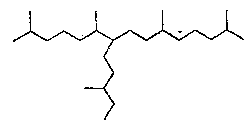Life on Earth is carbon-based. Some of the carbonaceous compounds which are produced by terrestrial life forms, such as bacteria and algae, have distinctive 3-D skeletons (stereochemistries)which allow these chemical fossils of past life to be identified in rocks which are billions of years old.
Amongst the most stable chemical fossils are a group of simple hydrocarbons with branched 3-D skeletons, known as acyclic isoprenoids. Examples include PME, the carbon skeleton of which is shown in Figure 1a and which is made with a preferred 3-d orientation only by an anaerobic methane-producing bacterium (Rowland et al., 1982). Another example is HBI, shown in Figure 1b, which is made only by a particular alga (a diatom) and the discovery of which, in rocks millions of years old, has been taken as evidence of diatoms in the terrestrial past (reviewed by Robson and Rowland, 1986). Such compounds are not known to be produced by abiotic processes and they can be identified in rocks even when they are present at very low concentrations. The discovery of acyclic isoprenoids of this type in extra-terrestrial rocks such as meteorites would be good evidence for early carbon-based life processes.
In contrast, some other hydrocarbons are not good indicators of life. For example, many polyaromatic hydrocarbons (PAHs) are produced by combustion of both simple abiotic carbonaceous compounds, such as methane, ethene and ethyne (as well as combustion of biotic organic compounds such as fossil fuels). Such PAHs tend to have flat, 2-D skeletons and none of the characteristic stereochemistry of the acyclic isoprenoids (see for example, the skeleton of the PAH phenanthrene shown in Figure 1c). The discovery of such compounds in carbonaceous rocks from the Solar System, particularly those that have been heated, is unsurprising, and at best, ambiguous evidence of past life.
Rowland, S.J., Lamb, N.A., Wilkinson, C.F. and Maxwell, J.R. (1982) Tetrahedron Letters 23, 101-104.
Robson, J.N. and Rowland, S.J. (1986) Nature 324, 561-563.
a. Skeleton of 2, 6, 10, 15, 19-pentamethyleicosane (PME) produced by Methanosarcina barkeri.
b. Skeleton of 2, 6, 10, 14-tetramethyl-7(3-methylpentyl)pentadecane (HBI) produced by Haslea ostrearia, a diatomaceous alga, as related alkenes.
c. Skeleton of phenanthrene, a polyaromatic hydrocarbon (PAH) produced by combustion of both biotic and abiotic carbonaceous materials.

Figure 1a. PME

Figure 1b. HBI

Figure 1c. Phenanthrene